
by Nathan Jones, Vertebrate Ecology Lab
June 2, 2008. Dutch Harbor, Alaska and the R/V Oscar Dyson – We arrived in Dutch Harbor very late, indeed. I think it was after 1 am when I finally unlocked the door to my room. Outside, the dusky, midsummer light of an Aleutian evening was still slowly fading in the fog. I closed the curtains and sank happily into bed.
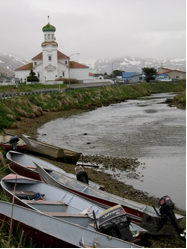
In the morning, I had just a couple hours free to take a stroll around Dutch Harbor, but I’ll be back again more than once this season; like many of the commercial fishing vessels, most all the research ships doing work in the Bering Sea must stop to exchange supplies or crew members in Dutch. This is a working town, in the truest sense. And, although it’s surrounded by beautiful wilderness, Dutch Harbor itself doesn’t see too many tourists!
Nonetheless I am fascinated and engaged by the sort of raw beauty that can be found in the industry of humankind. Although Dutch Harbor has gained an outsized, ribald reputation, I find it is also earnest, industrious, and indomitable. There is a certain honesty in the worn deck lines, rusty rails, towers of shipping containers, and acres of crab pots: This is how fish is brought to your dinner plate.
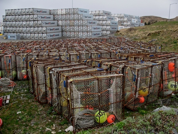
By noontime, we are motoring out on the NOAA ship Oscar Dyson, at last! But, we’re not going very far, at first. We’ll need to stop for a few hours in a protected bay to calibrate all the sensitive oceanographic equipment, and make sure it’s all working properly. Planning, testing, and instrument calibration are crucial first steps in scientific fieldwork. In fact, there are sometimes years of discussion, coordination, and planning that take place among scientists before they even start out to measure anything at all! And, after all that planning, you can imagine how important it is to make sure that all the instruments are functioning correctly.
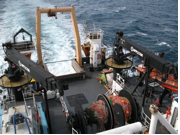
The Oscar Dyson has been designed specifically for scientific work, and is outfitted with the latest in acoustic instrumentation. It has several types of fishing nets, designed to catch things that range in sizes smaller than a flea, to as big as you! There are cranes, winches, and other equipment to haul these net loads of fish and invertebrates from the water, and deposit them on board for processing.
The hull of the ship is insulated to reduce vibrations and noise from the engines that would otherwise interfere with the acoustic measuring devices. This makes the ship very “quiet”, from an underwater perspective. The ship has a room full of computers that scientists use to manipulate and interpret their data, and a laboratory room where up to half a dozen people can work at once sorting fish, dissecting things, and running ocean water through test equipment.
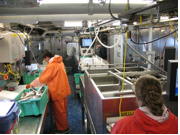
While we’re underway this summer, the scientists will measure all the basic environmental conditions like sea temperature, salinity, pressure, and depth. There are also instruments designed to “see” the fish and little invertebrates as the ship passes over them. This is done by sending out multiple sound signals of varying frequencies, and measuring the “echo” that different signals make as they bounce off objects below the ship: objects like the sea bed, of course, but also fish, kelp, and even dense groupings of euphausiids (krill). These tiny invertebrates are about the size of ants, and often are so small that you need a microscope to study them thoroughly, but they get so dense at times that they appear as fuzzy clouds of color on the monitor.
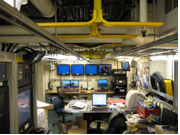
The acoustic equipment is something like a very sensitive, very sophisticated “Fish-Finder”, which is a device that lots of people have mounted on their own private boats. So, scientists look at the high frequency images to find euphausiids near the surface, and to the low frequency images for fish near the bottom. (If you think about the physics of sound and water, can you imagine why the low frequencies might be better for finding larger fish near the bottom?).
You can see more pictures of the boat and its crew, and really geek out on more specifics, at this site: http://www.moc.noaa.gov/od/

